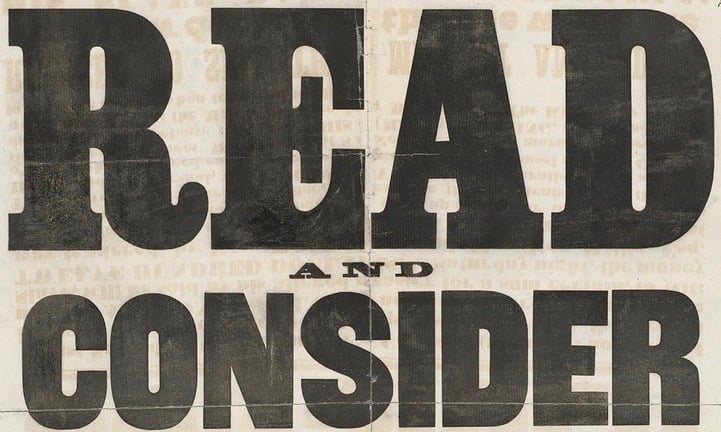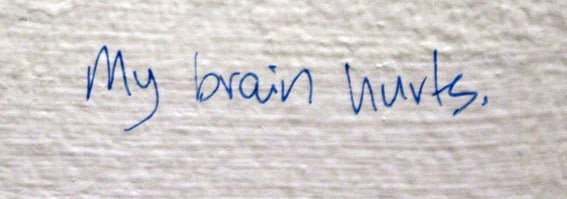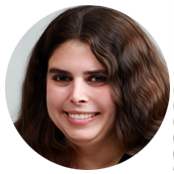
Inference questions appear frequently on the SAT Reading and Writing section. Answering inference questions correctly requires the ability to take information given in the text and then draw logical, supported conclusions from it.
What are the different kinds of inference questions asked on the SAT Reading and Writing Section, and how should you go about answering them? I've got the answers for you in this article.
feature image credit: Fellow citizens of Massachusetts! by Boston Public Library, used under CC BY 2.0/Cropped from original.
What Are Inference Questions?
Inference questions ask you to draw a conclusion based on information implied or suggested in a passage or passages. The ideas being asked about are not directly stated in the text, so you’ll have to use context clues from the text to complete it with the most logical conclusion.
The digital SAT takes a more straightforward approach to wording Reading and Writing questions and answers than the old SAT. Because of this, there are only two ways that Inference questions are worded on the digital SAT:
- “Which choice most logically completes the text?”
- “Based on the texts, how would the author of Text 2 most likely respond to the underlined claim in Text 1?”
That’s it! If you run into questions that use this wording, you’ll know you’re dealing with inference questions!
Correct answers to inference questions will draw a conclusion based on ideas that are indicated in the text provided. Incorrect answers will either contradict information provided in the text or draw conclusions based on evidence that isn’t provided in the passage.
Of course, the best way to get a handle on inference questions is to look at examples from official digital SAT practice exams. Keep reading for three sample inference questions…and how to answer them!
Inference Questions: 3 Examples
Inference questions ask you to fill in missing information. Here’s an example from a real digital SAT practice exam:
Example 1:
Euphorbia esula (leafy spurge) is a Eurasian plant that has become invasive in North America, where it displaces native vegetation and sickens cattle. E. esula can be controlled with chemical herbicides, but that approach can also kill harmless plants nearby. Recent research on introducing engineered DNA into plant species to inhibit their reproduction may offer a path toward exclusively targeting E. esula, consequently ______.
Which choice most logically completes the text?
A. making individual E. esula plants more susceptible to existing chemical herbicides.
B. enhancing the ecological benefits of E. esula in North America.
C. enabling cattle to consume E. esula without becoming sick.
D. reducing invasive E. esula numbers without harming other organisms
The correct answer is D.
Explanation:
If recent research offers a new approach to controlling E. esula that doesn’t kill other plants, we can use it to stop the spread of E. esula without killing other plants. The last sentence suggests that this new approach stops E. esula from reproducing, not that the new approach makes E. esula more vulnerable to existing chemical herbicides. That eliminates choice A. The last sentence mentions nothing about this new approach enhancing the ecological benefits of E. esula. That eliminates choice B. The last sentence mentions nothing about the new approach making E. esula digestible for cattle. That eliminates choice C. The last sentence does state that using this new approach will stop E. esula without harming other plants, so the correct answer is D.
Example 2:
Let’s look at another sample inference question. Keep in mind that the question is worded exactly the same way as the previous one!
If some artifacts recovered from excavations of the settlement of Kuulo Kataa, in modern Ghana, date from the thirteenth century CE, that may lend credence to claims that the settlement was founded before or around that time. There is other evidence, however, strongly supporting a fourteenth century CE founding date for Kuulo Kataa. If both the artifact dates and the fourteenth century CE founding date are correct, that would imply that ______
Which choice most logically completes the text?
A. artifacts from the fourteenth century CE are more commonly recovered than are artifacts from the thirteenth century CE.
B. the artifacts originated elsewhere and eventually reached Kuulo Kataa through trade or migration.
C. Kuulo Kataa was founded by people from a different region than had previously been assumed.
D. excavations at Kuulo Kataa may have inadvertently damaged some artifacts dating to the fourteenth century CE.
The correct answer is B.
Explanation:
Example 3
Let’s look at one last sample inference question from an official digital SAT practice exam so we can really get a handle on how to answer these:
Text 1
When companies in the same industry propose merging with one another, they often claim that the merger will benefit consumers by increasing efficiency and therefore lowering prices. Economist Ying Fan investigated this notion in the context of the United States newspaper market. She modeled a hypothetical merger of Minneapolis-area newspapers and found that subscription prices would rise following a merger.
Text 2
Economists Dario Focarelli and Fabio Panetta have argued that research on the effect of mergers on prices has focused excessively on short-term effects, which tend to be adverse for consumers. Using the case of consumer banking in Italy, they show that over the long term (several years, in their study), the efficiency gains realized by merged companies do result in economic benefits for consumers.
Based on the texts, how would Focarelli and Panetta (Text 2) most likely respond to Fan’s findings (Text 1)?
A. They would argue that over the long term the expenses incurred by the merged newspaper company will also increase.
B. They would recommend that Fan compare the near-term effect of a merger on subscription prices in the Minneapolis area with the effect of a merger in another newspaper market.
C. They would encourage Fan to investigate whether the projected effect on subscription prices persists over an extended period.
D. They would claim that mergers have a different effect on consumer prices in the newspaper industry than in most other industries.
The correct answer is C.
Explanation:
6 Superior Strategies for Attacking Inference Questions
So how do you attack inference questions?
I've compiled for you a bunch of different strategies for attacking inference questions. Some of these strategies work better if you read the passage a certain way, but much of the advice is useful no matter what your method of reading the passage.
Strategy 1: Recognize Inference Question Wording
Understanding what an inference question is actually asking can be hard to wrap your head around. The good news is that inference questions are worded one of two ways every time:
- “Based on the texts, how would the author of Text 2 most likely respond to the underlined claim in Text 1?”
Inference questions will always ask you to finish a sentence in a passage with the answer choice that provides the most logical conclusion based on what’s already been revealed in the text.
Incorrect answer choices will draw conclusions based on suggestions that aren’t made in the text, or they’ll draw conclusions that don’t make sense based on information provided in the text. Correct answer choices will always draw conclusions based on suggestions that are made in the text–and there will only be one answer choice that does this.
 Aches and pains by Quinn Dombrowski, used under CC BY-SA 2.0/Cropped from original.
Aches and pains by Quinn Dombrowski, used under CC BY-SA 2.0/Cropped from original.
Strategy 2: Look For Context
On inference questions, the best strategy is to look at the sentences before and after the phrase/sentence/lines you’re given in the question.
Sometimes even that isn't enough, and you'll need to know the main point of the passage or the perspective of the author in order to properly answer an inference question. Don't panic if this is the case - if you're struggling to answer the question, mark it in your test booklet and come back to it after you’ve answered other relevant questions (like questions about the paragraph/section the lines in question are in, or even questions about the whole passage).
Strategy 3: Answer In Your Own Words
For me, this strategy is the key to answering inference questions correctly. If I don't come up with the answer in my own words before I look at the answer choices, I get tripped up by answer choices that include irrelevant information (because I search for ways to prove that they are true) - this is a waste of time and an easy way to get confused.
The College Board knows that you've been trained (via high school English classes) to see as many different points of view as possible and is banking on you getting bogged down in wrong answers that are interpretations that “seem like they could be true.”
Don't be fooled: there is only one right answer on the SAT, and if you start with the right answer in your own words, it’s a lot easier to choose the right answer in THEIR words. But how do you figure out what a phrase, line, or sentence means/suggests/indicates, or what its implications are?
Strategy 4: Nail Down Other SAT Reading Skills
The skills you need to answer inference questions build on other SAT Reading skills.
In order to answer inference questions successfully, you'll need all the following skills:
- Vocab in Context – you need to be able to interpret complex words included in different answer choices in the context of the text provided
- Little Picture – you need to figure out what concepts presented in the answer choices mean and when they’re discussed in the passage
- Big Picture – you need to be able to scan passages to get a sense of the attitude of the author
- If all else fails, you can use author technique skills to figure out the general tone of the passage
 Nail by Craig Dugas, used under CC BY-SA 2.0.
Nail by Craig Dugas, used under CC BY-SA 2.0.
Nail down those SAT Reading skills better than some person nailed down that...nail.
Strategy 5: Eliminate Answers
As you may or may not already know, the fundamental rule for SAT Reading and Writing is that you must eliminate 3 wrong answers. For inference questions, this can be difficult, because even if you answer the question in your own words correctly, the inference you make may not ne what they’re looking for.
How do you figure out if an answer can be eliminated? After all, you have to go through the text and then match it with these weird answers that have all these different components. That last part, however, actually makes going through the answer choices to inference questions easier, because if any part of the answer choice does not match with the passage, then you can eliminate that answer choice.
Plug each answer choice into the text provided and see if it provides a logical conclusion to the discussion occurring in the text. If it doesn’t, mark it off. By process of elimination, you’ll narrow it down to only one answer–the one that provides a logical conclusion to the ideas presented in the text.
Inference Questions: Practice Time!
I've included three medium-level official practice questions for you to...practice...with. All of these practice inference questions come from digital SAT practice exam 2, module 1.
Practice Question #1:


Practice Question #2:

Practice Question #3:

Answer Key:
1. D
2. A
3. B
 Can we go for a walk? by Kathleen Tyler Conklin, used under CC BY 2.0/Cropped from original.
Can we go for a walk? by Kathleen Tyler Conklin, used under CC BY 2.0/Cropped from original.
In Conclusion
- Inference questions ask you to draw the most logical conclusion based on evidence directly stated in the text.
- In order to successfully answer inference questions, you must make sure you understand the question
- Look for context to help if the lines/words mentioned in the question aren't enough
- Answer the question in your own words before looking at the SAT’s answer choices
- Nail down other SAT Reading skills to help you with inference questions
- Eliminate three wrong answers
What’s Next?
Did you find this SAT Reading skill-focused article useful? You're in luck - we have a whole series of SAT Reading skills articles! You can find them all collected here in our ultimate guide to SAT Reading, or you can jump to specific articles on main point, little picture, function, vocab in context, author technique, analogy, and paired passage questions
Feeling overwhelmed and not sure what the best way to practice SAT Reading is? Find out how to read the passage and how to attack paired passages.
Worried about running out of time on SAT Reading? You’re not alone. Read more about how to avoid getting caught in a Reading time crunch here.
Do you find that breaking down questions by skill type and drilling them really works for you? Consider the PrepScholar platform to help you with your SAT test prep!












